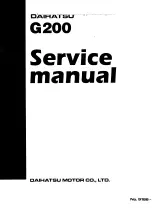
–
Do not touch the component or the gas generator within 10
min of airbag being deployed.
–
Do not use electrical probe in the return circuit.
1.6.1.4 Air-Conditioning Refrigerant
Skin contact may cause frostbite.
Must comply with the instructions provided by the manufacturer
to avoid the exposed lights. Wear suitable goggles and
protective gloves.
If refrigerant come into contact with skin or eyes, you should
immediately wash the contacted area with water. Apply the
appropriate cleaning solution and rinse the eyes. Do not rub,
as the case may need to seek medical assistance.
Air-Conditioning Refrigerant - Operations to be Avoided
–
Do not store refrigerant at a place with direct sunlight or
heat sources.
–
When filling, the refrigerant bottles must not be upright.
Keep valves down.
–
Do not expose refrigerant to frost or snow.
–
Do not drop the refrigerant bottle.
–
Do not, in any case, directly discharge refrigerant to the
atmosphere.
–
Do not mix refrigerants, such as the R12
(dichlorodifluoromethane) and R134a (tetrafluoroethane).
1.6.1.5 Adhesives and Sealants
and
Flammable Materials - Comply with the smoking ban.
Flammable Materials should normally be kept in no-smoking
areas. When using, keep surrounding areas clean, by using
such as disposable paper to cover and protect the seat cover.
Make use of the brush and the container, including the reused
container. Label the container properly .
1.6.1.6 Engine Coolant
.
For example, isopropyl alcohol, ethylene glycol, ethylene
glycol, methanol.
Highly flammable flammable.
Used in the vehicle engine coolant circulation system,
windshield washer fluid.
When heated, engine coolant (ethylene glycol) may produce
steam. Avoid inhaling the vapor.
After direct contact with engine coolant through the skin,
directly absorbed dose may reach toxic or harmful dose. If
swallowing engine coolant, it may be life-threatening. The
person must be taken to hospital and seek medical treatment
immediately.
These products must not be used in conjunction with the
ordinary food processing or connected with the drinking water
supply system.
1.6.1.7 Asbestos
Inhaling asbestos dust likely to cause lung damage, and even
cause cancer.
Asbestos waste should be wet before handling. Place in sealed
containers and mark clearly at the surface of the container to
facilitate safe handling. If you need to try to cut or drill materials
containing asbestos, you should make the materials wet first,
and only use low-speed hand tools or power tools.
1.6.1.8 Battery Acid Fluid
The gas released when charging is explosive. Do not conduct
fire operations near a charging battery or a recently charged
battery.
Maintain good ventilation.
1.6.1.9 Brake Fluid
.
It is a little irritating when comes into contact with the skin and
eyes. Avoid the brake fluid coming to contact with eyes, skin.
The risk of inhaling brake fluid at room temperature is not high,
because its pressure is very low.
1.6.1.10 Chemical Materials
Pay attention, when using, storing and handling chemical
material, such as, solvents, sealants, adhesives, coatings,
resin foam, battery acid, engine coolant, brake fluid, fuel,
lubricating oil and grease. They may be toxic, harmful,
corrosive, and irritating or highly flammable, and there is a high
risk of odor and dust.
The impact of long term exposure to chemicals may be acute
or chronic, temporary or permanent, cumulative, life-
threatening, or may affect life expectancy.
Chemical Materials - Operations to be performed
Vehicle Overview
Health and Safety
1-29
EC718/EC718RV EC715/EC715RV 10/2009
Summary of Contents for EC715 2009
Page 4: ......
Page 330: ...Next Step 10 End 2 248 Fuel System JL4G18 D Engine EC718 EC718RV EC715 EC715RV 10 2009 ...
Page 1164: ......
Page 2008: ......
















































